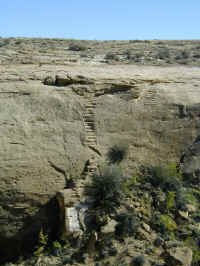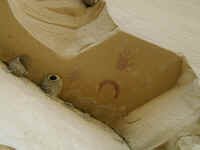10/14-16
As we drove toward Chaco Canyon we felt that we had made a good choice for an alternative destination to the Ute Mountain Tribal Park. Chaco Canyon was the heart of the culture for the Ancient Puebloans and what they left behind is magnificent.
We planned to explore the Great Houses built by the people and to look for the ancient pictograph thought to be a representation of the Super Nova that occurred nearly 1,000 years ago.
The more we learned about the Chaco Culture, the more amazed we became. While Europe was in its "Dark Ages", Chaco was the center of the entire San Juan Basin culture. It was connected to more than 150 other Great Houses by over 400 miles of hand built roads. They traded for goods as far away as central Mexico and the Pacific Ocean.
Today the sites of Chaco, just like the other Ancient Puebloan sites, are considered part of the sacred homeland of the Hopi, the Pueblo peoples of New Mexico and the Navajo. The Chaco complex is so large that even after spending 3 days exploring, we still had not seen everything.
One day we climbed to the mesa above the canyon, following a thousand-year-old staircase trail. The view from the top were definitely the way to see the sheer magnitude of the ruins. Check out the view of Pueblo Bonito. This great house is the largest of the Chaco complexes and contains over 600 rooms and 40 kivas.
| We also followed prehistoric roads to other ruins, and viewed other prehistoric stairways that we could hardly believe people would (or could) use. |
Exploring another ruin, Pueblo del Arroyo, we found one structure that still had the original plaster on the walls, but even more impressive, it still had its original ceiling. Apparently, when the roof collapsed on the room above, the debris prevented any moisture from getting to the room below and the dry air preserved the wood log ceiling.
Some of the structures are also believed to have astronomical markers built into them. Many are oriented along solar, lunar and cardinal (north, south, east & west) directions and some of the windows only let direct sunlight in on certain days. There were also markers for the Vernal and Autumnal equinoxes. These were believed to have helped farmers with their planting schedules.
| Even more amazing is the existence of a pictograph that is thought to depict the super nova in 1065 that created the Crab Nebula. It is believed that the super nova was visible around the world, even during daylight. This cosmic event was recorded in China, Japan and in pictographs on the Hopi Mesas and in Chaco. We were able to view the glyph on the Hopi Reservation, but they requested that we not photograph it. However, in Chaco photos were allowed. How's this! |
Then, just like the other Ancient Puebloan sites in the 4 Corners region, by the 1200's the area was abandoned!
From Chaco we are heading to the valley along the Rio Grande River. It is now believed that the Ancient Puebloans migrated to that region, mixing with the people already there and building new pueblos. But before we leave the canyon we must stop to appreciate the plaque placed outside the visitors center:
"In 1987 Chaco Canyon National Historical Park was designated a World Heritage Site. It joined a select list of protected areas around the world whose outstanding natural and cultural resources form the common inheritance of mankind."

